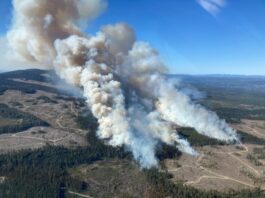
Hello, Earthlings! This is our weekly newsletter on all things environmental, where we highlight trends and solutions that are moving us to a more sustainable world. (Sign up here to get it in your inbox every Thursday.)
This week:
- The controversy over the term ‘citizen science’
- Environmentally themed murals are everywhere
- What the new UN report warning of climate impacts means for Canadians
The controversy over the term ‘citizen science’

The term citizen science has been around for decades. Its original definition, coined in the 1990s, refers to institution-guided projects that invite the public to contribute to scientific knowledge in all kinds of ways, from the cataloguing of plants, animals and insects in people’s backyards to watching space.
Anyone is invited to participate in citizen science, regardless of whether they have an academic background in the sciences, and every year these projects number in the thousands.
Recently, however, some large institutions, scientists and community members have proposed replacing the term citizen science with “community science.”
Those in favour of the terminology change — such as eBird, one of the world’s largest biodiversity databases — say they want to avoid using the word citizen. They do so because they want to be “welcoming to any birder or person who wants to learn more about bird watching, regardless of their citizen status,” said Lynn Fuller, an eBird spokesperson, in a news release earlier this year.
Some argue that while the intention is valid, the term community science already holds another definition — namely projects that gather different groups of people around environmental justice focused on social action.
To add to the confusion, renaming citizen science could impact policies and legislation that have been established in countries such as the U.S. and Canada to support projects and efforts in favour of citizen science.
For example, if we suddenly decided to call all species of birds “waterbirds,” then the specific meaning of this category of bird species that lives on or around water would eventually be lost. This would, in turn, make communication between people and the various fields of science incredibly difficult.
A paper published in Science magazine last month pointed out some of the reasons why rebranding citizen science in the name of inclusion could backfire.
Caren Cooper, a professor of forestry and environmental resources at North Carolina State University and one of the authors of the paper, said that the term citizen science didn’t originally mean to imply that people should have a certain citizenship status to participate in such projects.
Rather, citizen science is meant to convey the idea of responsibilities and rights to access science.
She said there are other terms being used to describe this meaning, including “public science, participatory science [and] civic science.”
Chris Hawn, a professor of geography and environmental systems at the University of Maryland Baltimore County and one of Cooper’s co-authors, said that being aware of the need for change is a good first step, but any decision to rename should be made carefully.
“We want to encourage people to really take a look at the field and look at the problems we have,” said Hawn, who emphasized that one of them is “that most of our participants in these large-scale projects … end up being mostly white.”
Cooper said there is no easy solution to the structural problems of class and race that pose challenges to inclusion in citizen science projects. Cooper and Hawn say they are calling for people to come together and dig deeper into this discussion.
“If people are already doing that kind of community science in terms of grassroots organizing and doing work that secures the interests of marginalized communities, then please use that term,” said Hawn. Otherwise, we should think about this in another way.
Hawn believes it’s essential to strategize ways to tackle racism, misogyny and other barriers enthusiasts and members of the scientific community face when it comes to accessibility and promoting more inclusion.
“It’s not that [rebranding] is not a good first step,” he said, “but it should be done with intention and done within a larger strategy.”
— Thaïs Grandisoli
Reader feedback
Last week, Maya Lach Aidelbaum wrote about why Canada geese seem to be in such abundance. Here’s what you had to say.
Bill Steers: “I disagree with your statement that they were almost extinct in the ’50s. I grew up in the early ’50s in northwest Ontario beside a river with a large beach. I recall every summer there being a flock of 60 to 80 birds — nowhere near extinct!”
Donna Dupas: “I’m left disappointed that the focus is largely about the impacts to us and our lovely urban settings… This is a complicated subject for sure and one that has numerous views and opinions. Your last paragraph sums it up…. I believe there is much to be gained when we look differently at the species we share this planet with.”
Old issues of What on Earth? are right here.
There’s also a radio show and podcast! Gadgets, fast fashion — things you want, but don’t necessarily need. As Canada’s economy works to bounce back as the pandemic wanes, What On Earth host Laura Lynch hears how endless economic growth is damaging the climate and what can be done to slow it all down to save the future. What On Earth airs Sunday at 12:30 p.m., 1 p.m. in Newfoundland. Subscribe on your favourite podcast app or hear it on demand at CBC Listen.
The Big Picture: Environment-themed murals
It might be because of a heightened awareness of the fragility of nature or perhaps a desire to beat back the tedium of the COVID-19 pandemic — or maybe both — but there seem to be a lot of more environmentally themed murals on display, particularly in urban settings. What on Earth? stalwart Emily Chung captured the image below in a Toronto alley. If you’ve seen some cool and/or inspiring murals in your neck of the woods, we’d love to see them. Please send photos to whatonearth@cbc.ca — we’ll share them in coming weeks.

Hot and bothered: Provocative ideas from around the web
-
A small-scale Mexican farmer found a way to reverse semi-arid land degradation with the help of two drought-tolerant plants common to Mexico: agave and mesquite. Agaves have shallow root systems and draw moisture directly from the air, storing it in their thick, thorny leaves. Mesquites, on the other hand, have extremely long roots and seek water deep underground.
-
Some scientists believe the northern part of the Gulf Stream is weakening because of melting ice from Greenland. This powerful water current shapes the climate on four continents, and its weakening could lead to consequences like faster sea-level rise in parts of North America and Europe, increased drought in mid-Africa and extreme weather events across the globe.
- Although there are hundreds of invasive species in our waterways, a new study by a Canadian marine ecologist found that only a small fraction of them have been studied more than once. She’s concerned about how little we know about marine invaders and the effects they’re having on their adopted ecosystems.
What the new UN report warning of climate impacts means for Canadians

Earlier this week, the United Nations Intergovernmental Panel on Climate Change (IPCC) issued a dire report warning that without a radical reduction of our greenhouse gas emissions, we are on a course for global warming that will have grave consequences.
Monday’s report said the planet has already warmed almost 1.2 C above pre-industrial levels. We are seeing the effects of climate change across the country, including more intense wildfires, heat waves and drought. Here are some of the impacts we can expect in Canada.
The Arctic
The Arctic is warming at more than twice the rate of the rest of the world, and according to the report, it’s “virtually certain” it will continue for the rest of the century. Polar regions have begun to experience extreme heat events at more than three times the global rate. According to the report, this is expected to continue and will lengthen the fire season.
Permafrost has been thawing in the Arctic since the 1980s. This is particularly concerning because it releases methane, another greenhouse gas that contributes to global warming.
Then there’s the ice. Arctic sea ice cover is at its lowest level since 1850, and the Arctic is projected to be practically ice-free at its summer minimum in roughly 30 years.
“We will probably see summers without Arctic sea ice before 2050 and the Greenland and Antarctic ice sheets will continue to shrink,” Ella Gilbert, a post-doctoral research assistant at the University of Reading who was not involved in writing the report, said in a statement.
“We may even be hurtling towards unpredictable and irreversible tipping points in the climate system.”
All these changes have a snowball effect. Polar regions are deeply important to regulating the global temperature. Less snow means more sunlight is absorbed by the darker water that’s been exposed, which in turn leads to further warming not only of the region, but also of the entire planet.
More heat events
Fires continue to rage across British Columbia, and the hottest temperature ever recorded in Canada was reached in June — 49.6 C in Lytton, B.C. The report says such heat events are expected to worsen.
In northern North America, which includes most of Canada, the report found that “temperature increases are projected to be very large compared to the global average, particularly in the winter.”
“Heat waves, and changes in fire weather … increase along with temperature,” said Greg Flato, senior research scientist with Environment and Climate Change Canada and vice-chair of the IPCC group that authored the report.
“The higher the temperature gets, the more frequent, and the more severe these heat waves will become and the more frequent and more severe the fire weather conditions will become.”
Oceans and water
The report found that it is “virtually certain” that sea levels will rise around the world throughout the 21st century.
“For coastal communities, that has implications then for the frequency or the likelihood of severe inundation flooding, high sea-level extremes … so depending on where you live, that will be an increasing threat,” said Flato.
The report found that the surface of the North Atlantic Ocean has warmed more slowly than the global average, or slightly cooled. But it has also increased in salinity, which can affect ecosystems.
In the Canadian Rockies, glaciers are melting, which may create more glacial lakes. Because of temperature differences, experts also expect to see shifts in when rain transitions to snow and the range of snow and ice conditions over the next few decades.
In Ontario, parts of Quebec and the Atlantic region, it’s very likely that there will be increases in the amount of rain as well as extreme precipitation. This means there is likely to be more flooding not only along our waterways, but also in places that don’t normally flood.
Hotter cities
Most people live in cities, and Canada is no different. These concrete jungles suffer from what is known as the urban heat island effect. Tall buildings close to one another prevent natural air circulation and also absorb more heat, which is then re-emitted at night.
In many cases, this means that air pollution worsens as surface ozone particles increase. This is exacerbated by rising fires and smoke.
More urban development and more frequent heat waves with more hot days and warmer nights will only add to the heat stress in cities.
Flato said this is why it’s important to cut emissions now.
“We do have the capability to limit warming if, collectively, we’re able to reduce emissions quickly enough and get to net zero by the middle of this century. We can limit warming to one and a half degrees or somewhere not too far above that,” Flato said.
“From my perspective, that’s kind of empowering, in the sense that there’s something we can do about it. It’s not an inevitable consequence.”
— Nicole Mortillaro
Stay in touch!
Are there issues you’d like us to cover? Questions you want answered? Do you just want to share a kind word? We’d love to hear from you. Email us at whatonearth@cbc.ca.
Sign up here to get What on Earth? in your inbox every Thursday.
Editor: Andre Mayer | Logo design: Sködt McNalty












